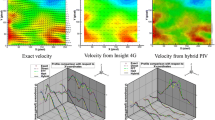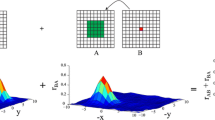Abstract
A new algorithm using polar coordinate system similarity (PCSS) for tracking particle in particle tracking velocimetry (PTV) is proposed. The essence of the algorithm is to consider simultaneously the changes of the distance and angle of surrounding particles relative to the object particle. Monte Carlo simulations of a solid body rotational flow and a parallel shearing flow are used to investigate flows measurable by PCSS and the influences of experimental parameters on the implementation of the new algorithm. The results indicate that the PCSS algorithm can be applied to flows subjected to strong rotation and is not sensitive to experimental parameters in comparison with the conventional binary image cross-correlation (BICC) algorithm. Finally, PCSS is applied to images of a real experiment.
Similar content being viewed by others
References
Adrian, R.J.: Particle-image techniques for experimental fluid mechanics. Ann. Rev. Fluid Mech., 23:261–304 (1991)
Raffel, M., Willert, C.E., Kompenhans, J.: Particle Image Velocimetry. 1st edn. Springer, Berlin, 1998
Malik, M., Dracos, T., Papantoniou, D.: Particle tracking velocimetry in three-dimensional flows, Part II particle tracking. Exp. Fluids, 15:279–294 (1993)
Ruan, X.D., Song, X.Q., Yamamoto, F.: Research on the algorithm of binary image cross-correlation for unsteady flow field measurement. Acta Mechanica Sinica 15:32–38 (1999)
Okamoto, K., Hassan, Y.A., Shmudtl, W.D.: New tracking algorithm for particle image velocimetry. Exp. Fluids, 19:342–349 (1995)
Song, X., Yamamoto, F., Iguchi, M., Murai, Y.: A new tracking algorithm of PIV and removal of spurious vectors using Delaunay tessellation. Exp. Fluids, 26:371–380 (1999)
Baek, S.J., Lee, S.J.: A new 2-frame particle tracking algorithm using match probability. Exp. Fluids, 22:23–32 (1996)
Hayami, H., Okamoto, K., Aramaki, S.: A trial of bench mark test for PIV. J. Vis. Soc. Japan, 17 (Suppl 1): 465–468 (1997)
Ruan, X.D., Wu, F., Yang, H.Y., Yamamoto, F.: Algorithm for automatically detecting spurious vectors in PIV data. Chinese J. Mech. Eng., 40:89–92 (2004) (in Chinese)
Author information
Authors and Affiliations
Corresponding author
Additional information
The project supported by the National Natural Science Foundation of China (50206019)
The English text was polished by Yunming Chen.
Rights and permissions
About this article
Cite this article
Ruan, X., Zhao, W. A novel particle tracking algorithm using polar coordinate system similarity. ACTA MECH SINICA 21, 430–435 (2005). https://doi.org/10.1007/s10409-005-0054-6
Received:
Revised:
Accepted:
Published:
Issue Date:
DOI: https://doi.org/10.1007/s10409-005-0054-6




